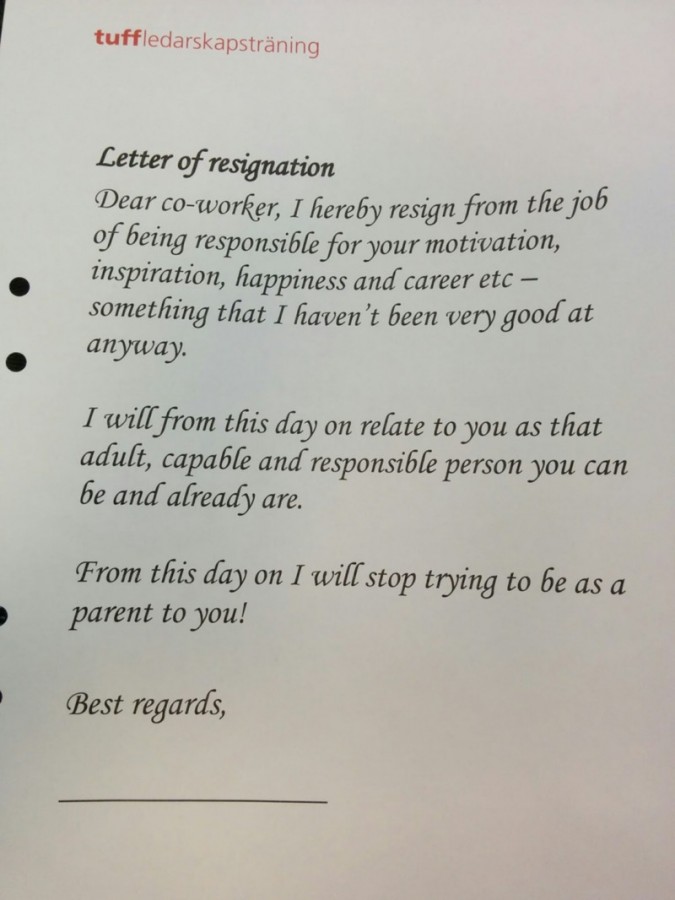By Lisa Gill for Enlivening Edge
Tuff Leadership Training is a company that trains managers in a style of leadership that produces motivated, responsible employees and self-reliant teams. Here we explore the core principles of their training and the skills needed to be a Teal team.
Last month I spent two weeks in Sweden with Karin Tenelius and Carl Erik Herlitz, founders of Tuff Leadership Training. I had been invited to co-write a book with Karin about her career of buying and transforming struggling companies into Teal organisations. As part of my research, I attended Step 1 of the Tuff Leadership Training course; four days of intensive leadership training involving practical exercises and plenty of feedback. Here’s what I’ve learnt…
Being versus doing
Alternative organisational structures are something of a trend right now; Zappos continues to receive press attention as the largest organisation to date to adopt the self-management system Holacracy—a system Medium recently ditched in favour of evolving their own approach—and I’ve seen more and more communities and resources springing up to support the movement from hierarchy to something more ‘bottom up’: The Ready,Future of Work, Responsive Org, RSA’s Reinventing Work Network, WorldBlu, Enlivening Edge, and others.
But there’s a risk of getting caught up in structure and ‘doing’, and neglecting the ‘being’ side of things. There is no shortage of literature out there on leadership and management thinking, but there’s a big gap between knowing and doing. It’s a question of habit, and as writer Charles Duhigg discovered in his book The Power of Habit, we can’t delete old habits but we can (with practice) replace them.
Empowering leadership
Before she started Tuff, Karin coached hundreds of unemployed people during the recession in Sweden in the 1990’s which enabled her to develop an extremely powerful technique. Where many job coaches pandered to their clients and did much of the work for them, Karin found it far more effective to relate to her clients as capable, making them entirely responsible for the outcome of the coaching sessions. She had been inspired by two books in particular: former President of Scandinavian Airlines Jan Carlzon’s Moments of Truth and Ricardo Semler’s Maverick — both examples of leaders who achieved great success by empowering front line teams and ‘leading by getting out of the way’. In 1999, she got the chance to put these radical ideas into practice when she was asked by the managing director of Freys Hotel to coach her employees in becoming a self-managing team.
Within just eight months, the hotel’s profit had risen by 26%. The success of this case led to Karin getting CEO assignments in two other small companies which enabled her to develop a comprehensive methodology for training teams to function independently without managers.
“I then decided that it was a good idea to teach these skills to managers and founded Tuff Leadership Training. The name indicates that the focus is on developing skills, rather than getting more knowledge, and the training involves a lot of personal feedback, with painful insights as a result!”
Co-founder Carl Erik, who originally qualified as a lawyer, then set about taking Karin’s method and expanding it into a replicable training programme. If Karin is the pioneer, Carl Erik is the settler. His rigorous pedagogical approach meant they could bring their leadership training programmes to managers all over the world — from Sweden to China to South America.
No more parents and children
At the heart of this training is the principle that when managers truly relate to employees as adults (instead of as parents to children) then employees are far more likely to be motivated and responsible. In Step 1 of the course, you get given the following imagined letter from an enlightened manager:

In fact, to promote their courses, Tuff runs 90-minute seminars provocatively called ‘Stop Motivating Your Employees!’ It’s a big mindset shift from managers doing something to employees to motivate them to being in such a way that they are motivated. People are naturally motivated, so if they aren’t, managers are probably getting in the way!
“The answer to the question managers often ask… — How do you motivate people? — is: you don’t. Man is by nature motivated… His behaviour is influenced by relationships between his characteristics as an organic system and the environment… Creating these relationships is a matter of releasing energy in certain ways rather than others. We do not motivate him because he is motivated. When he is not, he is dead.” — Douglas McGregor
(Quoted in ‘Freedom Inc’ by Brian M Carney and Isaac Getz)
Both the seminars and the courses give managers the opportunity to practice these new leadership skills — like exercising a new muscle — through roleplay scenarios, demonstrations, and plenty of feedback from both the trainer and each other. It’s all about raising awareness, moving from ‘unconscious incompetence’ to ‘conscious incompetence’. ‘Tuff’ in Swedish means ‘tough’ and the training is definitely hard work. For many managers, it feels extremely uncomfortable because the very skills they’ve been recruited and promoted for become their pitfalls when it comes to practicing empowering leadership. Even the seasoned coaches who were in my training group found it difficult to truly give up responsibility to the coachee. The default we have learnt so well in our workplaces is either nurturing parent (taking care of people and the problem) or critical parent (admonishing people and solving the problem for them).
Skills for Teal
Just as managers have to un-learn being responsible, employees have to learn how to be responsible after years of education and work experience where much of the thinking has been done for them. I’ve spoken to many people in startups who you might assume are used to taking responsibility and who enjoy operating within a flat organisational structure. However, as startups hit a growth tipping point, that parent-child tendency creeps in again. I’ve had many a conversation with founders in startups who lament employees who aren’t responsible enough and employees in startups who lament founders hogging all the decision-making power! And never the twain shall meet…
So whether you work in a big organisation or a small one, how do you flourish as Teal team? In her 15 years of coaching teams in self-management, Karin’s found that three skills make all the difference:
1. Addressing climate issues
The climate in the company is what it feels like to work there. Karin insists that if a company doesn’t have a productive working climate, you can forget about Teal. She’s developed a process for cleaning the air in organisations which she calls ‘shifting the climate’. It starts with a process called ‘moose heads’. A moose head is a metaphor for something that’s taboo in an organisation; usually an issue someone has with a colleague or the way things are.
For example, one team Karin worked with believed there was a ‘secret troika’ among them — a trio of people making decisions behind the others’ backs. Issues like these produce a toxic climate that gets in the way of teams and individuals being effective. They’re called ‘moose heads’ because it’s like dumping a rotting, bloody moose head on the table in front of everyone — it’s not pleasant but it’s important to get it out in the open.
Once people have named and shared these issues, it’s then time for them to decide together the ground rules moving forward for the climate they do want. This skill relates to the Wholeness and Evolutionary Purpose principles of Teal, encouraging people to always be authentic and creating the space for people to challenge and question the way things are and how people are being.

2. Decision-making
Skill number two is decision-making. Often people in organisations tell me they’ve tried involving people in decision-making before and it’s been slow and ineffective. This is probably because they used consensus; consensus usually is slow and ineffective. Karin coaches people in decision-making methods such as Will Schutz’s concordance or Sociocracy’s consent decision-making. It’s a middle ground between top-down and consensus which means everyone has a say, but you don’t need everyone to agree. This training often involves practicing decision-making as a group with fictional, complex scenarios which helps people who aren’t used to having authority to experience the impact their decisions have in a safe space. At Freys Hotel, the team was even able to design their own decision-making process regarding each other’s salaries.
3. A coaching leadership style
One of the Tuff Leadership Statements is “Polite or effective — it’s up to you!” Effective communication is founded on relating to each other as capable and responsible. This means being able to be straight with each other, to give and receive feedback, to practice generative listening, and many other related skills that are very often not the norm in conventional workplaces. In Teal organisations, employees are responsible for hiring and firing, so a coaching leadership ability is crucial.
Whether you operate in a hierarchy or a flat organisation, I believe these skills are invaluable to being a high-performing team. When I interviewed employees in some of Karin’s companies, all of them told me self-management is hard — but fun. Out of the three skills mentioned above, almost everyone said the moose heads process is tough — even if employees have been doing it for years — but essential.
Around the time I was in Sweden, I read Google’s latest research experiment, Project Aristotle, which found that the number one dynamic of their most successful teams was psychological safety. In other words, teams where members felt safe to take risks, be vulnerable in front of each other, and be truly honest with each other.
Watch this space
Well, having returned to the UK, my home office now looks like a scene out of the movie “A Beautiful Mind,” as I try to turn my hours of recorded interviews and insights into a compelling book. It will be a mix of case studies and stories, methods and philosophies, successes and failures, which I hope will inspire people to experiment in their own work to create Teal ways of working. In the meantime, I’d love for people to share their thoughts and questions about this article and some of the ideas I’ve mentioned.
 Lisa Gill is founder and director of Reimaginaire which works with leaders to reimagine their organisations, bringing people practices and ways of working into the 21st century.
Lisa Gill is founder and director of Reimaginaire which works with leaders to reimagine their organisations, bringing people practices and ways of working into the 21st century.




Lisa, how do those teams or their companies go about discovering their evolutionary purpose?
Hi George! So I talked to Karin about your question. In the companies she’s been involved in, her role has been as a facilitator. So in an existing company, she might facilitate sessions for the group to look at the existing purpose and decide if it’s inspiring enough. All of these companies set aside half or whole days regularly (at least once a month?) to explore what’s happening in the organisation (including bringing up moose heads if there are any) so the purpose can be discussed in this forums (or indeed at any time). It naturally evolves in this sense. For example, one company Karin owns, Mötesbokarna (a telemarketing company) had no vision/purpose as the former owner was only numbers driven. The first purpose the group came up with after Karin became CEO was about serving customers but as they experienced this new self-managed way of working, they decided they could hold another purpose: to be a healthy, positive company that offered healthy, positive working conditions for the people who worked there. When she worked with a hotel, their purpose evolved beyond just running a great hotel to encompass inspiring other workplaces. In a new company, people are attracted to the evolutionary purpose of the founder and connect to that and it continues to evolve and develop as needed.
In essence, Karin coaches people in the skills and some examples of tools and then the responsibility lies with the group to evolve purpose, structure, ways of working and so on. So the discovering of the evolutionary purpose varies from company to company. Hope that makes sense and goes some way to answering your question?
> Hope that makes sense and goes some way to answering your question?
It does, and it seems that for most people the difference between a purpose or even healthy purpose on one hand and evolutionary purpose on the other hand, is the most difficult thing to really get from Frederic’s book.
Thanks for a good read. I am curious if you can say more about the process referred to for sharing moose heads? What are the steps? How is safe psychological space created? Thank you.
Hi Tree. Thanks for commenting. I’d say it’s better to talk to Karin about this one in terms of the steps. I’ll offer my thoughts, however. From what I’ve learned, the safe psychological space is created first by giving people the choice. You can’t do the moose head process without people signing up to it. Second, if managers are present, they need to have the capacity to receive feedback (almost always THEY are a moose head themselves) and the ability to ‘sit with things’ – it gets uncomfortable but everyone has to agree not to defend or justify, just to speak and listen. Metaphorically, it’s like each person putting their moose head on the table one by one and simply observing them. When people are done putting moose heads out, then you clear them away and decide what climate you DO want to create. What ground rules might we have? How can each of us take responsibility for this new way of being? The facilitator’s role is very important. Karin says it’s all down to the skill of the facilitator – being able to hold the space and leave the responsibility with the group, not taking it themselves.
Sorry, adding another comment here because i neglected to check the box to register to receive comment replies on the above, and the only way i see to rectify that is to add another comment.
Lisa, thanks for sharing! It sparked the following question….. How to create an ecosystem at work which support the individual and collective UN-learning process? I think of an ecosystem as my feeling tells me that a set of practices might not be enough for such a complex process. Is there an end of the unlearning process?….or is it life long learning and unlearning? Curious to hear how the un-learning process can be consciously supported in a long term.
Thanks for sharing such a thoughtful insight and question Vihra. I think that’s the million dollar question, in fact! Personally, I think it’s about life-long learning and unlearning. I believe every organisation needs to find its own way of creating a safe psychological space for these things to flourish and for people to bring their whole selves to work. These things are so subjective. Even if you asked a room of people from the same company to talk about what respect means to them, you’d get very different answers. In this case, the set of practices that Karin introduces is just the beginning. The real magic happens afterwards! That’s what I hope to capture in the book 🙂
Fabulous question, Vihra! Appreciating the wisdom of Lisa’s response! I might add that I follow Buckminster Fuller’s suggestion that the quickest way to move out of the old, is to create and inhabit the new. With reference to un-learning, that means, to me, instead of resisting, removing, demolishing the old, start acting from the new. The old persists, and there are ways to helping it dissolve, but the focusing more energy and attention on the new helps it become the new automatic, habitual way of being and doing, to the extent we practice it! Does that make sense to folks here?
Your body will have shed a million dead cells before you finish reading this comment. Living systems thrive at the boundary between chaos and order. Learning, unlearning, re-learning and creating new things to learn and do, inhabit this space.
It was always so, but VUCA conditions make it highly visible. Mechanistic structures and mindsets created a paralysing kind of order. Organic, living mindsets give rise to agile, dynamic ordering systems. Intrinsic motivation is key, psychological safety is enabling. People don’t need motivating, they need support for their intrinsic aliveness. Most of us have had years of parenting and education toward compliance. After a while most organisations develop habits and embed them in their people. Sometimes they call them “processes”. They become part of the structure, so we have to pay attention to the external as well as the internal constraints.
Zig Zigler responded to the challenge that motivation doesn’t last by saying that neither does bathing. It is recommended daily. That still applies with self-motivation. So yes, Vihra, it is not just lifelong, it is life itself and the ecosystem has to be one that both creates the enabling space and the active culture of mutual support and encouragement to keep the reinvention continuous. Every day the question is present and alive – What else is possible?
Hi Lisa, thanks for such interesting reflections. I was wondering how it will be made career development processes with employees in the future? And in the present, which measures do you think are the best to use for this purpose?
Because if it is true that the future will be about career self-management, it is also true that not all the People have the needed skills to adopt this proactive atittude and they might Need help from their organizations.
I would also be please to hear your thoughts about how can employee dialogue be promoted (communication between team leaders/managers and employees?.
Thank you in advance
You’re welcome, glad you enjoyed it! Career development is something people often ask me about in this model. There’s no easy answer, it just depends on what the individuals and the group decide together. Usually it moves away from being about job title and more towards what value people offer. In terms of not all people having the needed skills to thrive in self-managing environments, I think these skills can be trained to a certain extent – as Karin does as outlined in this article – but also I think it’s important to allow people the freedom to engage at their highest appropriate level. This will vary for people depending on where they are in life, what work they do, how involved they are etc. and not to judge this – it’s natural for everyone to be different.
How do you promote dialogue between team leaders/managers and employees? That’s a big question! Again, I’d say in the context of this article, it’s about training managers and employees to choose another way of being – one that is adult to adult and relates to people’s potential. This then allows for open dialogue, feedback, coaching etc. Hope that helps!